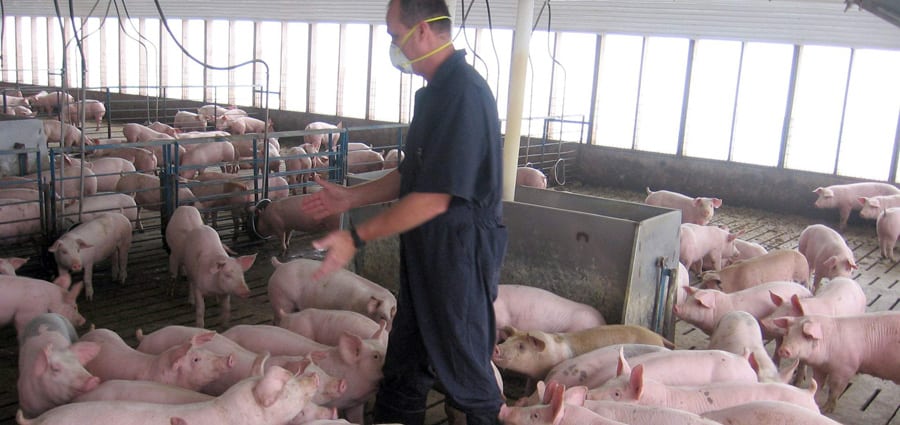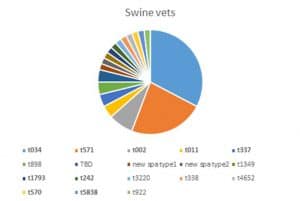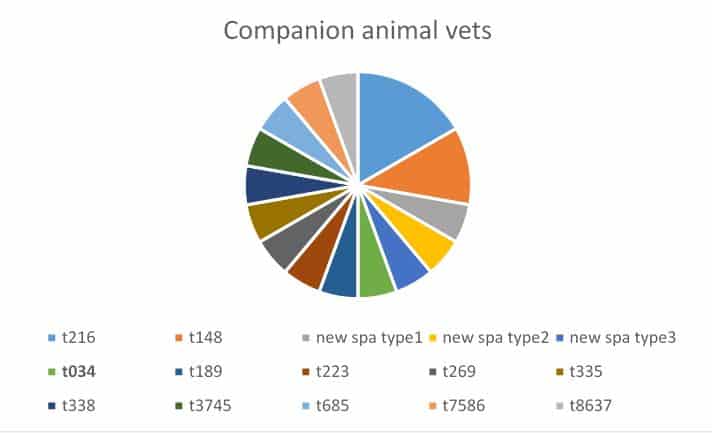
Project Description
RELATED PROJECT:
MRSA Colonization and Infection in Swine Veterinarians
Dates: 2016 – 2022
The importance of the human-animal interface as a source of emerging infectious diseases is universally recognized. People having regular animal contact are at the front line for exposure to known and emerging pathogens, and veterinarians provide a unique window into occupational risks for emerging zoonotic diseases. A 5-year longitudinal cohort study of US swine veterinarians will be conducted to understand the exposure and health risks attributable to pig exposure for three important emerging zoonotic pathogens that are endemic in the US swine industry: 1) Livestock associated S. aureus (including MRSA and multidrug resistant S. aureus); 2) Influenza A viruses; 3) Hepatitis E virus. A control group of companion animal veterinarians without contact with swine will be included for comparison of exposure and health risks, and to enable calculation of risks attributable to swine exposure.
The specific aims are:
-
- Determine the relative risk of MRSA and multiple drug-resistant S. aureus (MDRSA) exposure, and associated health events, in swine veterinarians and companion animal veterinarians;
- Determine relative risks for influenza A virus (IAV) exposure and disease in swine veterinarians and a control population, and estimate the relative likelihoods of bidirectional transmission events;
- Estimate the risk of Hepatitis E (HEV) exposure and seroconversion in swine veterinarians.
The study includes routine quarterly sampling to assess exposure, and opportunistic sampling associated with n relevant health events occurring during the study. The S. aureus component focuses on health risks in the subset of subjects that become permanently colonized with swine-origin S.aureus, and includes assessment of trends in antibiotic resistance following regulatory changes in antibiotic use in the swine industry. The IAV component is directed at furthering understanding the relative importance of human-to-pig and pig-to-human transmission to the overall epidemiology of influenza at the pig-human interface. The HEV study is directed at assessing short-term and longer term trends in occupational risk of HEV exposure and infection in swine industry workers.
Previous publications relevant to this project:
- Prevalence and Characterization of Staphylococcus aureus in Growing Pigs in the USA
- Comparative Prevalence of Immune Evasion Complex Genes Associated with β-Hemolysin Converting Bacteriophages in MRSA ST5 Isolates from Swine, Swine Facilities, Humans with Swine Contact, and Humans with No Swine Contact
In this 5-year project, we will compare the rates of self-reported clinical illnesses likely to be related to three zoonotic agents (S. aureus/MRSA; influenza A virus, Hepatitis E virus) in cohorts of swine veterinarians and companion animal veterinarians. Rates of exposure will be compared based on quarterly submission of nasal swabs (S. aureus and influenza), or by collecting three blood samples from the swine vets over the course of the study (Hepatitis E virus). Sampling and survey data collection are conducted quarterly in March, June, September and December each year. None of the 117 participants has withdrawn from the study, and the group has maintained high compliance in sample collection (~ 98%) and survey completion (~95%). Data obtained over the last year are consistent with the earlier years and confirm that the swine veterinarians test positive for S. aureus much more often than the companion animal veterinarians do, and that they are predominantly carrying S. aureus variants of swine origin. For the most recent completed sampling in June 2019, prevalence of S. aureus (72%) and MRSA (12%) in swine veterinarians were again much higher than in the companion animal control group (37% and 2% respectively). The prevalences of S. aureus and MRSA in the companion animal are similar to historic data for the general US population. Although prevalence is higher in the swine veterinarians than the control group, there appears to be no indication of increasing MRSA prevalence in swine veterinarians to date in the course of this study, or compared to our earlier study in 2013/2014.
Based on spa typing of all isolates, about 80% of the swine vet isolates are ‘livestock associated’ variants commonly found in pigs (Figure 1). With one exception, putative livestock variants have not been detected in companion animal vets. One companion animal veterinarian continues to be consistently positive for the ST398/t034 spa type that is most common in pigs and swine veterinarians. We have ascertained that this participant has daily contact with the six horses they own. As ST398 S. aureus (including t034) are known to be relatively common in horses, this is the likely origin of exposure. Serum samples continue to be collected from swine veterinarians for Hepatitis E serology. To date, 114 samples have been obtained, including from 57 of the 69 subjects, and the target of three samples per subject has been attained for 21 veterinarians. Because three more collection events are planned, we anticipate obtaining over 200 samples, including multiple samples from at least 50 participants (currently 36), which should enable reasonable estimation of seroprevalence and incidence of seroconversion to Hepatitis E virus.
We have not confirmed the presence of influenza virus in quarterly nasal swabs submitted for S. aureus culture. Targeted sampling of participants with influenza like symptoms during the winter of 2018/2019 yielded 46 samples for influenza testing, of which four were influenza virus positive. The positive samples are undergoing RNA sequencing for further characterization. This approach will be replicated in the winters of 2019/2020 and 2020/2021. Survey compliance for health events has been excellent (>95%), but interim analysis has not been conducted.
Figure 1: Distributions of S. aureus spa types in June 2019 nasal swab samples of swine veterinarians and companion animal veterinarians (spa types in bold consistent with livestock origin)




